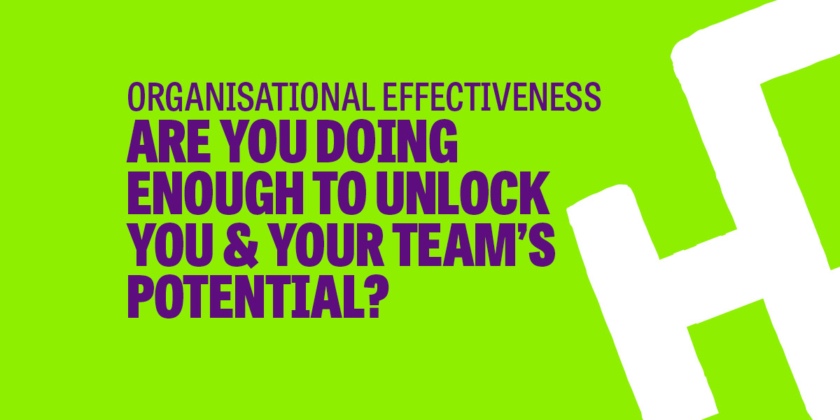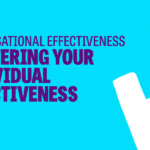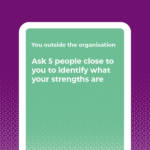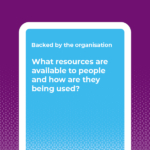In today’s competitive business landscape, attracting and retaining your talent is a critical challenge for organisations.
Organisational Effectiveness (OE) stands as an absolute cornerstone of any HR team’s plans when, focusing on driving high performance in individuals and teams while unlocking their full potential to drive business performance.
At its very core, OE is about understanding the skills, knowledge and behaviours needed now, and identifying where are the gaps so that you can ensure that you are fit for the future to deliver your business goals.
It’s all about finding the way forward, bridging the gap between the two through some key initiatives and interventions. And let’s not forget performance and potential are not static so being agile, keeping things simple but ensuring you are planning for the future is critical to planning your OE next moves.
In this article, we explore the impact of organisational effectiveness, from enhancing employee skills to driving innovation to creating a competitive advantage.
Let’s look at unlocking an individual’s potential
How to take hold of our own careers
What can you do to improve your team’s productivity and impact?
Unlocking an Individual’s Potential:
Assessing and optimising our most valuable asset, our people, is vital for achieving organisational effectiveness. But to truly understand the competencies, talents, and ambitions of individuals, we must dive deep into their skills, strengths, and aspirations.
By gaining this understanding, we can empower them to reach their full potential and drive the success of our organisation. In this section, we will explore three areas through which supports our employees: performance management, career possibilities, and competency frameworks, all leading to effective succession planning.
Performance Management:
Performance management goes way beyond just evaluating what some one is doing well or where they can develops; it’s about having a great conversation and joining up a persons personal and professional growth. One powerful approach is to conduct employee surveys and collect feedback. So think about how you are creating the right environment for these conversations, how you want people to feel and what mechanisms do you have to give a well rounded, fair and honest appraisal of someone’s performance now and in the future.
Career Possibilities:
Understanding our employees’ career aspirations is crucial for encouraging engagement and retention. Ensuring regular and meaningful career conversations play a pivotal role in this process. Instead of treating these as tick-box exercises, we can utilise them as opportunities to understand an employee’s skills and strengths in their current role.
By identifying areas where additional learning, development or support may be needed, we can equip them with the tools and resources necessary to excel in their current positions. This also enables us to dig down and discuss career growth opportunities and align individual aspirations with the organisation’s goals.
Competency Frameworks and Succession Planning:
We should understand that a well-defined competency framework serves as a roadmap for individual and organisational success. By developing customised competency frameworks that align with our business objectives and values, we create clarity around the skills, knowledge, and behaviours required for various roles within our organisation. This framework allows us to identify high-potential employees and nurture their growth through targeted development initiatives. It also enables effective succession planning, ensuring a smooth transition of talent and maintaining business continuity.
By adopting these key strategies, we can unlock the true potential of our workforce, enhance employee engagement and retention, and drive overall organisational success.
Remember, our people are our greatest asset, and investing in their growth and development is an investment in the future of our organisation. Let’s create a culture that values and nurtures our employees, enabling them to thrive and contribute to our shared success.
To get help with if this would work for you and your organisation take a look here.
How to take hold of our own careers
At LTT our approach to career progression is showing people the art of the possible!
Career progress is a big deal in organisational effectiveness (OE). It’s not just about job titles or salary increases; it’s about helping employees grow and achieve their aspirations. Regular conversations about career development can uncover a whole host of valuable insights into your team’s goals and dreams. By understanding what drives each team member, you can create a more engaged and motivated workforce.
To work towards enhancing performance and promoting career growth, it’s essential to create a supportive environment. This involves providing the right resources, such as training and development opportunities, to help employees acquire new skills and grow professionally. Additionally, fostering a culture of continuous learning and feedback can further support employees in reaching their full potential – that’s our aim, yes?
A supportive environment also means offering mentorship and coaching to help employees navigate their career paths. By providing this guidance and support, you can empower employees to take ownership of their development and pursue opportunities for growth.
Overall, prioritising career progress and creating that supportive environment we all work towards can lead to a more engaged, motivated, and high-performing team, a team that ultimately contributes to the overall effectiveness of your organisation.
Key point of note : Simply offering training courses or online learning subscriptions isn’t enough. We need a more thoughtful approach to get the results you want.
Click here you need to chat over how you can support your staff in career progress.
A consideration may be using a form of personality and psychometric assessments, these can provide insights into an individual’s personality traits, work preferences, and potential areas for development. This area of assessments is not only used in the recruitment phase of employment but can provide some real valuable insights into an individual’s strengths and areas for development, in turn helping them and their managers create targeted development plans.
It’s super important to acknowledge that not everyone may be receptive to or understand the value of this type of assessment. Consideration around this method should be taken into account at all levels of the organisation.
By implementing some of these strategies, your organisation can gain a thorough understanding of individual skills and strengths, supporting the workforce in achieving high performing standards.
A crucial point to emphasise during any of these processes is that assessing an individual’s ability to perform their job is not about questioning their current capabilities. Instead, it should be encouraged to create a personalised development plan that helps with both individual and organisational goals.
Taking hold of your own career and empowering your employees to manage their careers is proven to keep them engaged and growing, especially in uncertain times. It’s a crucial element for your company’s success and talent retention.
Establishing clear and transparent career pathways and opportunities for professional growth is a proven method for attracting, retaining, and nurturing exceptional talent.
Empowering individuals to take charge of their career development and providing the necessary support along the way requires us to consider: are our organisation’s career pathways clearly outlined and easy to navigate?
At Let’s Talk Talent, we endorse the 70/20/10 model for staff development. While this model places a significant amount of responsibility on individuals for their own growth, it’s crucial to focus on the 30% that HR can directly influence.
Through Organisational Effectiveness, now is the ideal time to provide more robust career development opportunities, actions that support and motivate your employees to explore various career paths within your organisation, not just the obvious ones.
Focus on self-discovery, values, and strengths. Encourage creative thinking and explore diverse career options – a great starting point to get this moving is the Let’s Talk Talent’s card deck bundle.
Here at LTT we delve into how our network can support our OE journey. To assist you, we offer a one-hour coaching session for each participant to address their specific needs, fostering ownership and creating a personalised action plan.
Review – What can you do to improve your team’s productivity and impact?
When it comes to reviews, it’s a must to reflect on past experiences to understand what has been successful and what hasn’t. This involves looking back at previous projects, initiatives, or strategies to identify strengths and weaknesses. However, it’s not enough to do this in isolation.
Analysing past experiences in isolation is like trying to navigate a complex maze with only one perspective. You might think you know the best path based on your limited view, but you could easily overlook hidden paths or obstacles. Seeking input from others is like having a team of navigators with different vantage points. They can help you see the maze from multiple angles, revealing new insights and ensuring you choose the most effective path forward.
But reflection and feedback should not be limited to periodic formal reviews. To truly embrace growth and continuous improvement, it’s important to establish a culture of ongoing feedback within teams and organisations. This means encouraging individuals to provide continuous feedback to one another, whether it’s through informal conversations, peer evaluations, or feedback tools.
In a continuous feedback culture, individuals and teams are empowered to give and receive feedback in a timely manner. It allows for the recognition of achievements, the identification of areas for improvement, and the sharing of best practices.
In addition, engaging in a continuous feedback culture promotes a sense of collective learning and development. It encourages team members to offer constructive criticism, share their perspectives, and suggest innovative ideas. This collaborative approach helps build trust, fosters open communication, and strengthens relationships within the team.
To establish this thriving continuous feedback culture, it’s important to provide the necessary resources and support. This can include training programs on effective feedback techniques, the implementation of feedback platforms or tools, and regular opportunities for team members to engage in feedback discussions. Providing Effective Feedback
By embracing continuous feedback and nurturing a culture of ongoing improvement, individuals and teams can continuously learn, grow, and adapt. It allows for agility in responding to changing circumstances, identifying emerging opportunities, and addressing potential challenges.
Ultimately, a robust feedback culture enhances individual performance, strengthens team dynamics, and drives organisational success.
Lets summarise some key steps to assess your team’s effectiveness and drive results:
Set Clear Goals: Define clear, achievable goals for your team. These goals should be specific, measurable, attainable, relevant, and time-bound (SMART).
Regular Performance Reviews: Conduct regular performance reviews to assess how well your team is meeting its goals. Provide constructive feedback and identify areas for improvement.
While some companies view performance reviews as unproductive, conducting them collaboratively with employees not only supports individual career advancement but also ensures collective growth.
A good example might be – Let’s say you’re part of a marketing team working on a campaign for a new product launch. In a team meeting, one member presents their initial concept, which receives positive feedback. However, another member raises a concern about the messaging being unclear and potentially confusing to the target audience. Instead of dismissing the feedback or waiting for a formal review, the team embraces a culture of continuous feedback. They have an open and constructive conversation, exploring the concern and discussing solutions. The team member who shared the initial concept appreciates the input and sees it as an opportunity to improve.
As a result, the team decides to revise the messaging to make it more concise and aligned with the campaign’s objectives. They collaborate, exchange ideas, and suggest improvements. This iterative feedback process harnesses the team’s collective intelligence, ensuring the campaign resonates with the target audience.
The continuous feedback culture empowers team members to contribute their perspectives, share concerns, and offer suggestions at any stage. By embracing this approach, the team maximises its potential, fosters innovation, and improves the quality of its work.
This example demonstrates how continuous feedback can enhance team performance and project success. By incorporating feedback into the workflow and valuing input from all members, the team develops a stronger sense of collaboration, continuously improves its work, and delivers better outcomes.
Encourage Collaboration: Build a culture of collaboration and teamwork. Encourage team members to share ideas, help each other, and work together towards common goals.
Provide Training and Development: Offer relevant training and development opportunities to help team members improve their skills and knowledge. This can include workshops, courses, and on-the-job training.
Recognise and Reward Achievements: Acknowledge and reward team members for their achievements and contributions. This can help boost morale and motivation.
Adjust and Adapt: Be willing to adjust your approach based on feedback and performance data. Continuously look for ways to improve team effectiveness and achieve better results.
To unlock the power of continuous feedback culture and drive organisational effectiveness, take action today. Schedule a call to discuss your organisation’s current state, future goals, and develop a straightforward roadmap to success. Let’s have a conversation where we can help you implement an Organisational Effectiveness project tailored to your needs.
To explore the Career Pathways & Development section of our website to discover how you can inspire your employees with the possibilities and empower them to take control of their professional growth. Find out how our resources can support their journey towards personal career development.



